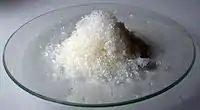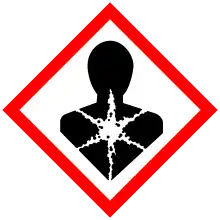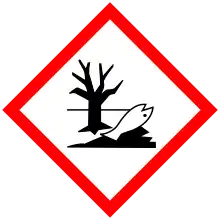 | |
 | |
| Names | |
|---|---|
| IUPAC name
Cadmium(II) nitrate | |
| Other names
Nitric acid, cadmium salt | |
| Identifiers | |
| |
3D model (JSmol) |
|
| ChEBI | |
| ChemSpider | |
| ECHA InfoCard | 100.030.633 |
| EC Number |
|
PubChem CID |
|
| UNII |
|
| UN number | 3087, 2570 |
CompTox Dashboard (EPA) |
|
| |
| |
| Properties | |
| Cd(NO3)2 | |
| Molar mass | 236.42 g/mol (anhydrous) 308.48 g/mol (tetrahydrate) |
| Appearance | White crystals, hygroscopic |
| Odor | Odorless |
| Density | 3.6 g/cm3 (anhydrous) 2.45 g/cm3 (tetrahdyrate)[1] |
| Melting point | 360 °C (680 °F; 633 K) at 760 mmHg (anhydrous) 59.5 °C (139.1 °F; 332.6 K) at 760 mmHg (tetrahydrate)[1] |
| Boiling point | 132 °C (270 °F; 405 K) at 760 mmHg (tetrahydrate)[2] |
| 109.7 g/100 mL (0 °C) 126.6 g/100 mL (18 °C) 139.8 g/100 mL (30 °C) 320.9 g/100 mL (59.5 °C)[3] | |
| Solubility | Soluble in acids, ammonia, alcohols, ether, acetone 5 g/L in methanol |
| −5.51·10−5 cm3/mol (anhydrous) −1.4·10−4 cm3/mol (tetrahydrate)[1] | |
| Structure | |
| Cubic (anhydrous) Orthorhombic (tetrahydrate)[1] | |
| Fdd2, No. 43 (tetrahydrate)[4] | |
| mm2 (tetrahydrate)[4] | |
α = 90°, β = 90°, γ = 90° | |
| Hazards | |
| GHS labelling: | |
   [5] [5] | |
| Danger | |
| H301, H330, H340, H350, H360, H372, H410[5] | |
| P201, P260, P273, P284, P301+P310, P310[5] | |
| NFPA 704 (fire diamond) | |
| Lethal dose or concentration (LD, LC): | |
LD50 (median dose) |
300 mg/kg (rats, oral)[2] |
| NIOSH (US health exposure limits): | |
PEL (Permissible) |
[1910.1027] TWA 0.005 mg/m3 (as Cd)[6] |
REL (Recommended) |
Ca[6] |
IDLH (Immediate danger) |
Ca [9 mg/m3 (as Cd)][6] |
| Related compounds | |
Other anions |
Cadmium acetate Cadmium chloride Cadmium sulfate |
Other cations |
Zinc nitrate Calcium nitrate Magnesium nitrate |
Except where otherwise noted, data are given for materials in their standard state (at 25 °C [77 °F], 100 kPa).
Infobox references | |
Cadmium nitrate describes any of the related members of a family of inorganic compounds with the general formula , the most commonly encountered form being the tetrahydrate. The anhydrous form is volatile, but the others are colourless crystalline solids that are deliquescent, tending to absorb enough moisture from the air to form an aqueous solution. Like other cadmium compounds, cadmium nitrate is known to be carcinogenic.
Uses
Cadmium nitrate is used for coloring glass and porcelain[7] and as a flash powder in photography.
Preparation
Cadmium nitrate is prepared by dissolving cadmium metal or its oxide, hydroxide, or carbonate, in nitric acid followed by crystallization:
- CdO + 2HNO3 → Cd(NO3)2 + H2O
- CdCO3 + 2 HNO3 → Cd(NO3)2 + CO2 + H2O
- Cd + 4 HNO3 → 2 NO2 + 2 H2O + Cd(NO3)2
Reactions
Thermal dissociation at elevated temperatures produces cadmium oxide and oxides of nitrogen. When hydrogen sulfide is passed through an acidified solution of cadmium nitrate, yellow cadmium sulfide is formed. A red modification of the sulfide is formed under boiling conditions.
When with caustic soda solution, cadmium oxide forms precipitate of cadmium hydroxide. Many insoluble cadmium salts are obtained by such precipitation reactions.
References
- 1 2 3 4 Lide, David R., ed. (2009). CRC Handbook of Chemistry and Physics (90th ed.). Boca Raton, Florida: CRC Press. ISBN 978-1-4200-9084-0.
- 1 2 "MSDS of Cadmium nitrate tetrahydrate". www.fishersci.ca. Fisher Scientific. Retrieved 2014-06-25.
- ↑ Seidell, Atherton; Linke, William F. (1919). Solubilities of Inorganic and Organic Compounds (2nd ed.). New York: D. Van Nostrand Company. p. 178.
- 1 2 James, D. W.; Carrick, M. T.; Leong, W. H. (1978). "Raman spectrum of cadmium nitrate". Australian Journal of Chemistry. 31 (6): 1189. doi:10.1071/CH9781189.
- 1 2 3 4 Sigma-Aldrich Co., Cadmium nitrate tetrahydrate. Retrieved on 2014-06-25.
- 1 2 3 NIOSH Pocket Guide to Chemical Hazards. "#0087". National Institute for Occupational Safety and Health (NIOSH).
- ↑ Karl-Heinz Schulte-Schrepping, Magnus Piscator "Cadmium and Cadmium Compounds" in Ullmann's Encyclopedia of Industrial Chemistry, 2007 Wiley-VCH, Weinheim. doi:10.1002/14356007.a04_499.
